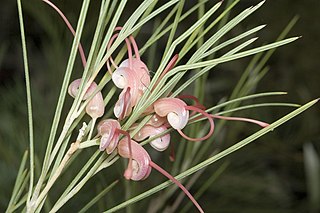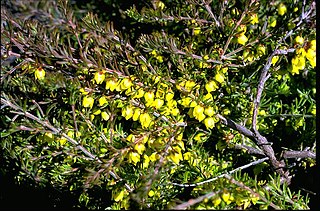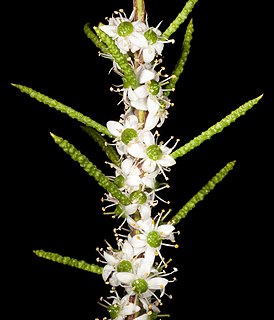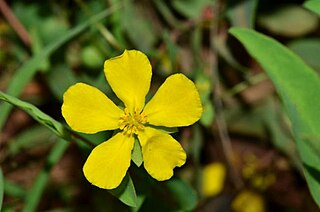
Melaleuca depressa is a plant in the myrtle family, Myrtaceae and is endemic to the south-west of Western Australia. It is a small, bushy shrub with clusters of yellow or cream flowers on the ends of its branches in spring.

Eremophila calorhabdos, commonly known as red rod or spiked eremophila, is a flowering plant in the figwort family, Scrophulariaceae and is endemic to the south-west of Western Australia. It is a distinctive shrub with erect, rod-like branches up to 2.5 m (8 ft) high, leaves with small teeth along the edges, and flowers that change from orange to lipstick pink as they open.

Eremophila ionantha is a flowering plant in the figwort family, Scrophulariaceae and is endemic to Western Australia. It is a shrub with many sticky branches, narrow, light green leaves and blue, purple or violet flowers.
Verticordia muelleriana is a flowering plant in the myrtle family, Myrtaceae and is endemic to the south-west of Western Australia. It is an openly branched shrub with relatively large, egg-shaped to circular leaves and long spikes of deep maroon coloured flowers in spring and early summer.
Grevillea eremophila is a species of flowering plant in the family Proteaceae and is endemic to the south-west of Western Australia. It is an erect shrub with leathery, linear to narrowly egg-shaped leaves with the narrower end towards the base, and creamy-white flowers.
Grevillea incurva is a species of flowering plant in the family Proteaceae and is endemic to inland south-western Western Australia. It is an erect shrub with linear adult leaves and clusters of creamy-yellow flowers.

Grevillea oncogyne is a species of flowering plant in the family Proteaceae and is endemic to inland areas of Western Australia. It is an erect to spreading shrub with linear, sometimes lobed leaves, and clusters of red or pinkish red flowers.

Kunzea montana, commonly known as mountain kunzea, is a flowering plant in the myrtle family, Myrtaceae and is endemic to the south-west of Western Australia. It is a shrub or small tree with more or less round leaves and heads of cream-coloured to pale yellow flowers on the ends of the branches in late spring. It is an uncommon species, growing on rocky mountain slopes, but all populations are conserved in the Stirling Range National Park.
Baeckea grandis is a species of flowering plant in the family Myrtaceae and is endemic to the south-west of Western Australia. It is an ascending to low-lying shrub that typically grows to a height of 0.1 to 0.5 metres and blooms between September and December producing pink and white flowers. Found on sand-plains and hills in the Mid West and northern Wheatbelt regions of Western Australia, it grows in sandy and lateritic soils.

Boronia purdieana is a plant in the citrus family, Rutaceae and is endemic to the south-west of Western Australia. It is a shrub with pinnate leaves and yellow, four-petalled flowers arranged singly in leaf axils.

Philotheca deserti is a species of flowering plant in the family Rutaceae and is endemic to inland Western Australia. It is an erect shrub with narrow spindle-shaped, glandular-warty leaves and white flowers arranged singly in leaf axils.
Goodenia eremophila is a species of flowering plant in the family Goodeniaceae and is endemic to inland areas of Western Australia. It is an ascending herb with linear to elliptic leaves and thyrses of blue flowers.

Teucrium eremaeum is a species of flowering plant in the family Lamiaceae and is endemic to the south-west of Western Australia. It is a perennial herb or shrub with small, linear to lance-shaped leaves and white or cream-coloured flowers.
Goodenia nuda is a species of flowering plant in the family Goodeniaceae and is endemic to the Pilbara region of Western Australia. It is an erect to ascending herb with elliptic to lance-shaped leaves at the base of the plant, and racemes of yellow flowers.

Bossiaea leptacantha is a species of flowering plant in the family Fabaceae and is endemic to southern Western Australia. It is a low, compact, spreading, many-branched shrub, the branches ending in cladodes, the leaves reduced to small scales, and with deep yellow, red and greenish yellow flowers.

Hibbertia silvestris is a species of flowering plant in the family Dilleniaceae and is endemic to the south-west of Western Australia. It is a prostrate to more or less erect or spreading shrub with hairy young branchlets, elliptic to egg-shaped leaves with the narrower end towards the base and yellow flowers with seven to ten stamens on one side of two softly-hairy carpels.

Daviesia dielsii, commonly known as Diels' daviesia, is a species of flowering plant in the family Fabaceae and is endemic to the south-west of Western Australia. It is on intricately-branched shrub with sharply-pointed, egg-shaped, vertically compressed phyllodes, and yellow and red flowers.
Lechenaultia juncea, commonly known as reed-like leschenaultia, is a species of flowering plant in the family Goodeniaceae and is endemic to the south-west of Western Australia. It is an erect, perennial herb or shrub with crowded, fleshy leaves, and pale blue flowers.
Grevillea ceratocarpa is a species of flowering plant in the family Proteaceae and is endemic to inland areas of the south-west of Western Australia. It is an erect or spreading shrub with softly-hairy, narrowly elliptic or narrowly egg-shaped leaves with the narrower end towards the base, and creamy-white flowers.
Lasiopetalum microcardium is a species of flowering plant in the family Malvaceae and is endemic to the south-west of Western Australia. It is a low, spreading or straggling shrub with hairy stems, heart-shaped leaves and blue, purple or white flowers.











